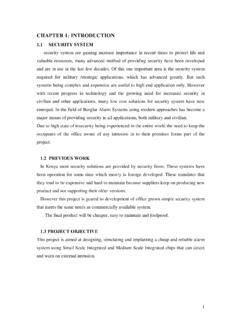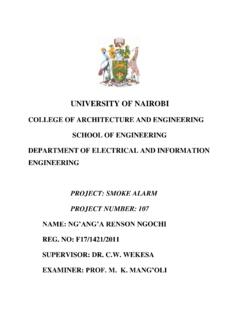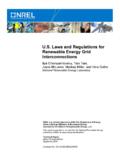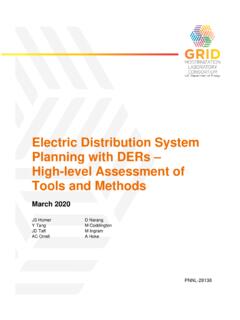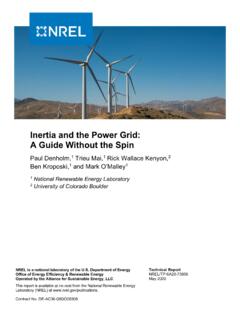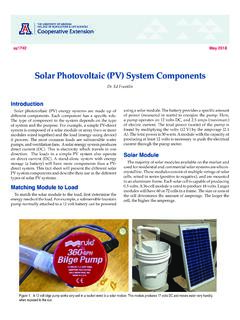Transcription of SOLAR PV SYSTEM SIZING - University of Nairobi
1 University OF Nairobi FEE 560: FINAL YEAR PROJECT SOLAR PV SYSTEM SIZING PROJECT 101 DONE BY: BOTTO VICTOR EMMANUEL REG. NO. F17/8231/2004 SUPERVISOR: DR. CYRUS WEKESA EXAMINER: MR. WALKADE MAY, 2009 DEPARTMENT OF ELECTRICAL AND INFORMATION ENGINEERING PROJECT REPORT SUBMITTED IN PARTIAL FULFILMENT OF THE REQUIREMENT FOR THE AWARD OF BACHELOR OF SCIENCE DEGREE IN ELECTRICAL AND ELECTRONIC ENGINEERING, University OF Nairobi . ii DEDICATION This project is dedicated to my dad and mum, Ephraim and Edith, my sister Susan , my brother Amos and the Muritu s (dad, mom, Shiro, Muthoni and Brian) who have been my second family. Your love, care and support throughout my life means the world to me. iii ACKNOWLEDGEMENT First and foremost I would like to thank God for bringing me this far.
2 I would be nowhere without Him. I extend my heartfelt gratitude to Dr. Cyrus Wekesa, my supervisor. My most heartfelt appreciation to the staff at Botto- SOLAR Ltd for their support during my project and for availing all the information necessary for the successful completion of this project. I would like to take to this opportunity to give special thanks to all my classmates. Your continual support and trust in my abilities has not gone unnoticed. iv Table of Contents List of CHAPTER 1 .. 1 INTRODUCTION ..1 Objectives .. 2 Project overview .. 2 CHAPTER 2: LITERATURE REVIEW .. 4 Photovoltaic module .. 4 Photovoltaic module performance .. 5 Factors affecting photovoltaic module performance .. 6 The photovoltaic effect.
3 8 Photovoltaic array .. 8 Electrical characteristics of PV modules .. 8 Efficiency ( ).. 9 Advantages and disadvantages of using photovoltaic 10 Batteries .. 13 Battery Types and 13 Lead-Acid Batteries .. 14 Nickel-Cadmium 16 Specifying Batteries ..16 v Charge Controllers .. 18 Types of controllers ..19 Blocking Reverse 20 Preventing 20 Control Set Points vs. Temperature .. 21 Control Set Points vs. Battery 21 Low Voltage Disconnect (LVD).. 22 Overload Protection .. 23 Inverters .. 23 23 26 CHAPTER 3: 27 Photovoltaic SYSTEM Photovoltaic SYSTEM SIZING worksheet 27 Estimating the Electric 27 Specifying an 29 SIZING and specifying a battery .. 30 SIZING and Specifying an Array.
4 32 Specifying a Controller .. 35 Summary of Steps for 36 CHAPTER 4: RESULTS ..39 Sample SYSTEM Problem .. 39 Stand-Alone PV SYSTEM parameters .. 39 SIZING Worksheet Calculations .. 40 vi SIZING for Other Areas .. 43 CHAPTER 5: CONCLUSION .. 44 Problems encountered .. 44 44 Conclusion .. 45 46 APPENDIX A .. 46 A1. Current situation of SOLAR energy utilization in Kenya .. 46 Available data sources on the SOLAR energy potential .. 46 World Radiation Data Centre (WRDC) .. 46 SOLAR Wind Energy Resources Assessment (SWERA) Data Base .. 48 APPENDIX B .. 50 Manufactures Data Sheets .. 50 APPENDIX vii List of figures Fig Stand-Alone PV Fig SOLAR Typical Current Voltage Curve of a Photovoltaic Fig Effects of Decreased Insolation Effect and Cell Fig (a) Series Controller (b) Shunt Fig Graph of Days of Usable Storage against Peak Sun Fig 50W Module Fig : Average Daily Radiation Measured at 15 Meteorological Stations in Kenya by Month of Year in the Period Fig.
5 Calculated Average Figures of Daily Global Horizontal SOLAR Radiation in Kenya Fig MS Excel Worksheet calculations for Table and Fig MS Excel Worksheet calculations for Tables and viii ABSTRACT Stand-alone PV (Photovoltaic SYSTEM ) systems operate reliably and are the best option for many remote applications around the world. Obtaining reliable long-term performance from a PV SYSTEM requires consistent SIZING calculations and knowledge of PV performance, use of good engineering practices when installing equipment and developing and following a complete operation and maintenance plan. This document presents recommended design practices for Stand-Alone photovoltaic (PV) systems.
6 The different components which comprise the PV systems are described and their characteristics enumerated. This information provides a base for the design. The SOLAR PV design technique takes into consideration estimated load requirements as the basis for SIZING the SYSTEM . The design technique is done through Worksheets. The calculations are simple and straight-forward. A practical sample SIZING problem is presented and is completed through the worksheets. SYSTEM component parameters have been obtained from manufacturer s data sheets which have been documented. It is important to note that the SOLAR radiation plays a great role in determining the SYSTEM size. As seen from the result section, locations with low SOLAR radiation require bigger SYSTEM size to compensate for low sun hours.
7 1 CHAPTER 1 INTRODUCTION Photovoltaic (PV) energy generating systems (or PV systems) convert the sun s energy directly into electricity using state-of-the-art semiconductor materials. PV systems produce clean, reliable energy without consuming fossil fuels and are used in a wide variety of applications. Some are called a stand-alone or off-grid SYSTEM , which means they are the sole source of power to a home, water pump or other load. Stand-alone systems can be designed to run with or without battery backup. Remote water pumps are often designed to run without battery backup, since water pumped out of the ground during daylight hours can be stored in a holding tank for use anytime.
8 In contrast, stand-alone home power systems often store energy generated during the day in a battery bank for use at night. Stand-alone systems are often cost-effective when compared to alternatives such as utility line extensions. Other PV systems are called grid-connected systems. These work to supplement existing electric service from a utility company. When the amount of energy generated by a grid-connected PV SYSTEM exceeds the customer s loads, excess energy is exported to the utility, turning the customer s electric meter backward. Conversely, the customer can draw needed power from the utility when energy from the PV SYSTEM is insufficient to power the building s loads.
9 Under this arrangement, the customer s monthly electric utility bill reflects only the net amount of energy received from the electric utility. The high initial costs of PV installation calls for a means of SIZING these systems to be able to match projected loads and applications. SIZING matches the user s energy needs with the appropriate SOLAR systems components. Typical applications of PV in use today include; Stand-alone power systems for cottages and remote residences, Remote telecommunication sites for utilities and the military, 2 Water pumping for farmers, Emergency call boxes for highways and college campuses, Street Lighting Grid Connected supply of Electricity Navigational aides for the Coast Guard PV Array Figure Stand-Alone PV SYSTEM Objectives The main objective of this project is to provide a means of SIZING Photovoltaic Systems supplying Stand Alone AC and DC loads.
10 The SIZING includes components which comprise the photovoltaic SYSTEM , namely; Photovoltaic Module Charge Controller Battery Storage Inverter Project overview The SOLAR PV design has been split up into four chapters consisting of Literature review, SYSTEM Design, Results and Recommendations. Charge ControllerBattery bank Inverter AC Loads DC Loads 3 Chapter 2 details any relevant theory which is crucial in further understanding of the design sections. Chapter 3 details the design and steps involved in SIZING the PV components. Chapter 4 presents a practical SIZING sample problem. Finally Chapter 5 includes recommendations and conclusion for the design technique presented The project report aims at providing an in-depth and accurate analysis and of PV SYSTEM design and relevant theory.

